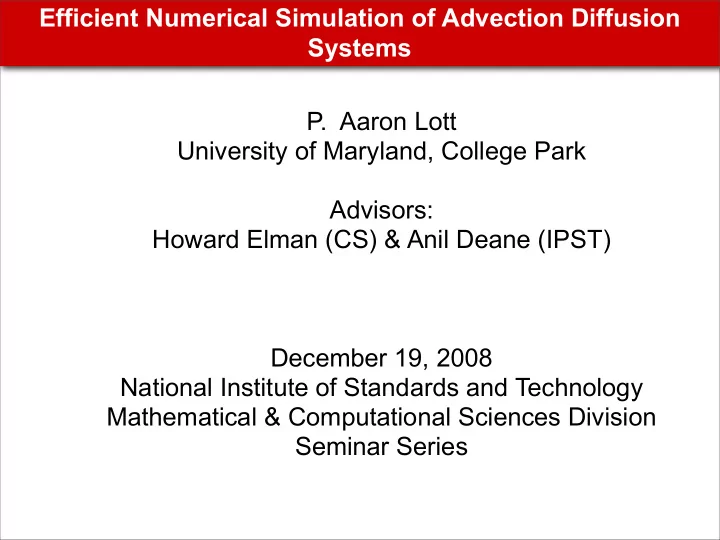

Efficient Numerical Simulation of Advection Diffusion Systems P. Aaron Lott University of Maryland, College Park Advisors: Howard Elman (CS) & Anil Deane (IPST) December 19, 2008 National Institute of Standards and Technology Mathematical & Computational Sciences Division Seminar Series
OUTLINE • History of machine and algorithmic speedup • Introduction to Advection-Diffusion Systems • Choice of Numerical Discretization • Development of Numerical Solvers • Results • Conclusion/Future Directions
Motivation - Efficient Solvers Faster machines and computational algorithms can dramatically reduce simulation time. (Centuries to milliseconds).
Motivation - Efficient Solvers Image courtesy of D. Donzis Simulating complex flows doesn’t scale as well.
Motivation - Efficient Solvers Complexity of Modern Linear Solvers Serial Parallel FFT Direct nlogn logn Multigrid Iterative n (logn)^2 GMRES Iterative n n Lower n logn Bound
Model - Steady Advection Diffusion Inertial and viscous forces occur on disparate scales causing sharp flow features which: • require fine numerical grid resolution • cause poorly conditioned non-symmetric discrete systems. These properties make solving the discrete systems computationally expensive .
Motivation - Efficient Solvers & Discretization High order methods are accurate & efficient.
Methods - Spectral Element Discretization Spectral elements provide: • flexible geometric boundaries • large volume to surface ratio • low storage requirements
Methods - Spectral Element Discretization The discrete system of advection-diffusion equations are of the form: When w is constant in each direction on each element we can use • Fast Diagonalization & Domain Decomposition as a solver.
Methods - Spectral Element Discretization Otherwise, we can use this as a Preconditioner for an iterative solver such as GMRES
Methods -Tensor Products What does mean? Suppose A k × l and B m × n The Kronecker Tensor Product a 11 B a 12 B . . . a 1 l B a 21 B a 22 B . . . a 2 l B . C km × ln = A ⊗ B = . . . . . . . . . a k 1 B a k 2 B . . . a kl B Matrices of this form have properties that make computations very efficient and save lots of memory !
Methods - Fast Diagonalization Matrix-vector multiplies ( A ⊗ B ) � u = BUA T done in O ( n 3 ) flops instead of O ( n 4 ) Fast Diagonalization Property C = A ⊗ B + B ⊗ A V T AV = Λ , V T BV = I C = ( V ⊗ V )( I ⊗ Λ + Λ ⊗ I )( V T ⊗ V T ) C − 1 = ( V ⊗ V )( I ⊗ Λ + Λ ⊗ I ) − 1 ( V T ⊗ V T ) Only need an inverse of a diagonal matrix!
Methods - Solver & Preconditioner We use Flexible GMRES with a preconditioner based on: • Local constant wind approximations • Fast Diagonalization • Domain Decomposition w ) P − 1 F ( � F P F u = Mf N 0 ˜ e ˜ � P − 1 = R T F − 1 R T w e ) R e F − 1 ( ¯ w 0 ) R 0 + ( ¯ e 0 F e =1 ˜ = ( ˆ M − 1 / 2 ⊗ ˆ M − 1 / 2 )( S ⊗ T )(Λ ⊗ I + I ⊗ V ) − 1 ( S − 1 ⊗ T − 1 )( ˆ M − 1 / 2 ⊗ ˆ M − 1 / 2 ) F − 1 e
Solver Results - Constant Wind w = 200( − sin ( π 6 ) , cos ( π 6 )) � Solution and contour plots of a steady advection-diffusion flow. Via Domain Decomposition & Fast Diagonalization. Interface solve takes 150 steps to obtain 10^-5 accuracy.
Preconditioner Results - Recirculating Wind w = 200( y (1 − x 2 ) , − x (1 − y 2 )) � Residual Plot above. Hot plate at wall forms • ( P + 1 ) [ 1 2 0 N + ( P + 1 ) ] internal boundary layers. additional flops per step
Conclusions/Future Directions Coupling Fast Diagonalization & Domain Decomposition provides an efficient solver for the advection-diffusion equation. • Precondition Interface Solve • Coarse Grid Solve (multilevel DD) • Multiple wind sweeps • Time dependent flows • 2D & 3D Navier-Stokes • Apply to study of complex flows
References M. Deville, P. Fischer, E. Mund, High-Order Methods for Incompressible Fluid Flow, Cambridge Monographs on Applied and Computational Mathematics, 2002. H. Elman, D. Silvester, & A. Wathen, Finite Elements and Fast Iterative Solvers with applications in incompressible fluid dynamics, Numerical Mathematics and Scientific Computation, Oxford University Press, New York, 2005. H. Elman, P.A. Lott Matrix-free preconditioner for the steady advection-diffusion equation with spectral element discretization. In preparation. 2008.
Recommend
More recommend